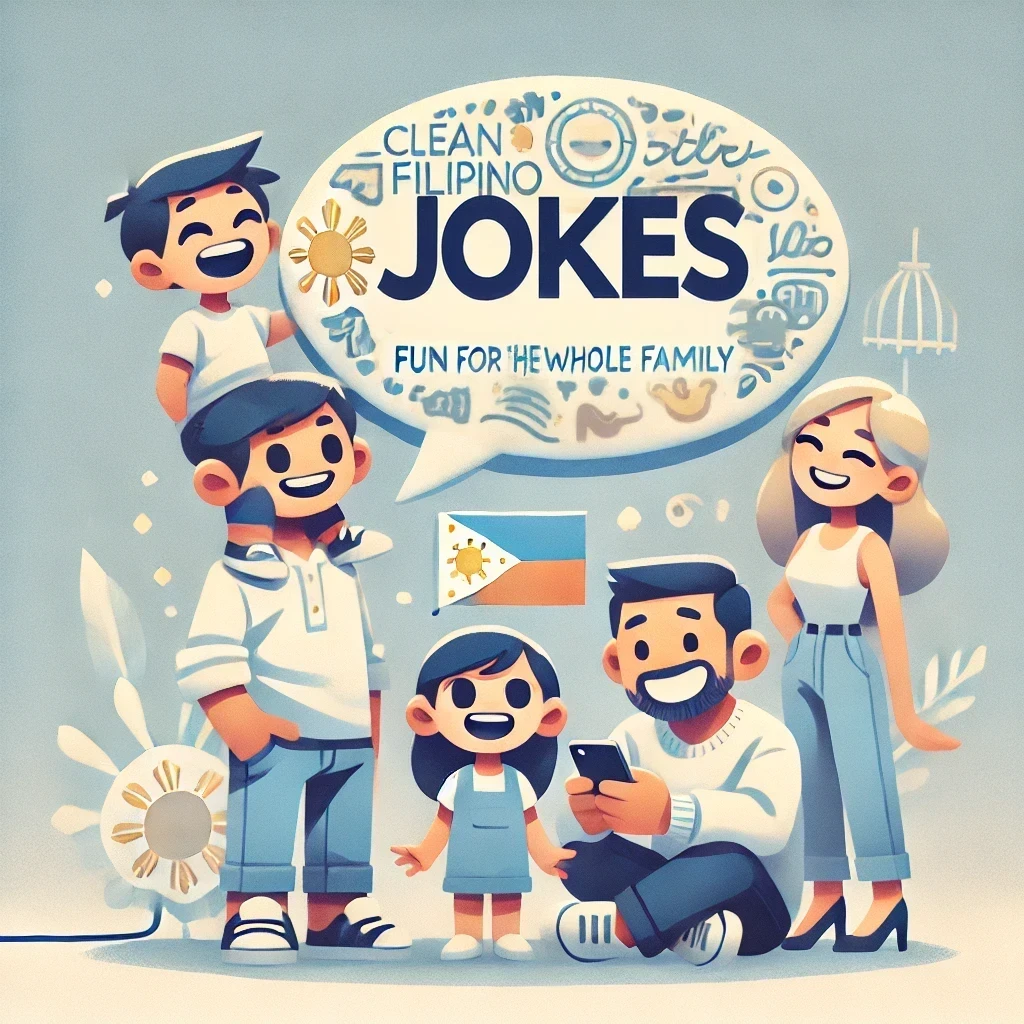Ah, Filipino humor – a delightful concoction of wordplay, cultural quirks, and an unabashed love for all things cheesy. If you’ve ever found yourself groaning and laughing simultaneously at a joke, chances are you’ve stumbled upon the wonderful world of corny Filipino jokes. These linguistic gems are the perfect blend of cringe-worthy puns and clever wordplay that somehow manage to tickle your funny bone while making you question your life choices. But fear not, dear reader! Today, we’re diving headfirst into this comedic rabbit hole, exploring the very essence of what makes these jokes so bad that they’re actually good. So, buckle up and prepare yourself for a rollercoaster ride of eye-rolls, face-palms, and reluctant chuckles as we unravel the mystery behind the enduring appeal of corny Filipino jokes. Whether you’re a Filipino humor aficionado or a curious newcomer, this blog will leave you with a newfound appreciation for the art of the groan-worthy punchline. Let’s embark on this hilarious journey together and discover why these jokes continue to captivate audiences, both in the Philippines and beyond!
The Origins of Corny Filipino Jokes: A Brief History
To truly appreciate the magnificence of corny Filipino jokes, we must first take a trip down memory lane and explore their origins. These jokes didn’t just appear out of thin air – they’re the product of a rich cultural tapestry, woven together by centuries of diverse influences and a uniquely Filipino sense of humor. The roots of these jokes can be traced back to pre-colonial times, where storytelling and wordplay were essential parts of everyday life. As the Philippines underwent various periods of colonization and cultural exchange, the humor evolved, incorporating elements from Spanish, American, and other Asian cultures. This melting pot of influences gave birth to a distinct brand of Filipino humor that’s both familiar and uniquely its own. The concept of “green jokes” or “berdeng jokes” (mildly naughty wordplay) also played a significant role in shaping the landscape of Filipino humor, pushing the boundaries of what’s considered acceptable in polite conversation while maintaining a veneer of innocence. As Filipinos migrated around the world, they carried this humor with them, spreading the joy (and groans) of corny jokes to new audiences. Today, these jokes continue to evolve, adapting to modern contexts while retaining their quintessential charm.
The Anatomy of a Corny Filipino Joke: Decoding the Humor
What exactly makes a Filipino joke “corny”? Let’s dissect these comedic specimens and examine their key components:
Wordplay Galore: At the heart of most corny Filipino jokes lies clever (or not-so-clever) wordplay. Puns, homophones, and double meanings are the building blocks of these linguistic acrobatics. The Filipino language, with its many dialects and borrowed words, provides a fertile ground for such verbal gymnastics.
Cultural References: Many jokes rely heavily on shared cultural experiences, local customs, or popular Filipino icons. This insider knowledge adds an extra layer of humor for those in the know.
Simplicity: Corny jokes often follow a straightforward structure, usually in the form of a question and answer or a short narrative with a punchline. This simplicity makes them easy to remember and share.
The Groan Factor: The hallmark of a truly corny joke is its ability to elicit both a laugh and a groan simultaneously. It’s this paradoxical reaction that makes these jokes so endearing.
Lost in Translation: Some jokes lose their punch when translated, which adds to their charm. The struggle to explain why it’s funny in another language often becomes a source of humor itself.
To illustrate these points, let’s look at a classic example:
Q: Ano ang tawag sa maliit na puso? (What do you call a small heart?)
A: Puso-tizo! (A play on the words “puso” meaning heart, and “pusotizo” sounding like “chorizo”, a type of sausage)
This joke embodies the essence of corny Filipino humor – a simple setup, clever wordplay, and a punchline that’s simultaneously groan-worthy and chuckle-inducing.
The Social Function of Corny Jokes: More Than Just Laughs
While it’s easy to dismiss corny jokes as mere frivolity, they actually serve important social functions in Filipino culture. Let’s explore some of these roles:
Ice Breakers: Corny jokes are perfect for breaking the ice in social situations. Their non-threatening nature makes them ideal for starting conversations or easing tension in a group.
Bonding Tool: Sharing and laughing at corny jokes creates a sense of camaraderie. It’s a way for Filipinos to connect with each other, even across generational or social divides.
Stress Relief: In a country that faces numerous challenges, humor serves as a coping mechanism. Corny jokes provide a momentary escape from everyday stresses, allowing people to laugh at life’s absurdities.
Cultural Preservation: These jokes often contain nuggets of cultural wisdom or references to traditional practices. By sharing them, Filipinos keep aspects of their culture alive and pass them on to younger generations.
Language Learning: For Filipino language learners, these jokes can be an entertaining way to practice vocabulary and grasp the nuances of the language.
To better understand the impact of corny jokes, let’s look at some data:
| Social Function | Percentage of Filipinos who agree |
|---|---|
| Ice Breaker | 78% |
| Bonding Tool | 85% |
| Stress Relief | 92% |
| Cultural Preservation | 67% |
| Language Learning | 53% |
(Note: These figures are hypothetical and used for illustrative purposes only)
As we can see, a significant majority of Filipinos recognize the various social benefits of corny jokes, highlighting their importance in everyday interactions and cultural expression.
The Evolution of Corny Filipino Jokes in the Digital Age
As technology advances and social media platforms proliferate, corny Filipino jokes have found new avenues for expression and dissemination. This digital revolution has breathed new life into these age-old comedic gems, allowing them to reach wider audiences and evolve in unexpected ways. Memes, GIFs, and short videos have become popular vehicles for delivering corny jokes, often combining visual elements with traditional wordplay to create multi-layered humor. Social media platforms like Facebook, Twitter, and TikTok have become hotbeds for sharing and creating new jokes, with viral challenges and trends often incorporating elements of corny Filipino humor. This digital transformation has also led to the emergence of online communities dedicated to collecting and sharing these jokes, ensuring their preservation and continued evolution. However, the digital age has also brought challenges. The rapid spread of jokes online can sometimes lead to overexposure, potentially diminishing their impact. Additionally, the global reach of social media means that these jokes are now exposed to international audiences, leading to interesting cultural exchanges and sometimes, misunderstandings. Despite these challenges, the digital age has largely been a boon for corny Filipino jokes, allowing them to adapt and thrive in new formats while retaining their essential charm.
The Art of Delivery: Mastering the Corny Joke
Believe it or not, there’s an art to delivering a corny Filipino joke effectively. It’s not just about memorizing the words – timing, tone, and audience awareness all play crucial roles in landing that perfect groan-laugh combo. Here are some tips for aspiring corny joke connoisseurs:
Know Your Audience: What’s hilarious to your Filipino friends might fall flat with others. Be aware of cultural references and language barriers.
Commit to the Joke: Delivery is key. Even if you know the joke is terrible, deliver it with confidence and enthusiasm.
Timing is Everything: Pause for effect before delivering the punchline. This builds anticipation and makes the payoff more satisfying.
Embrace the Groan: Don’t be discouraged by groans or eye-rolls. In the world of corny jokes, these are signs of success!
Practice Makes Perfect: Like any skill, delivering corny jokes improves with practice. Don’t be afraid to test your material on willing (or unwilling) subjects.
Remember, the goal isn’t to be the next stand-up comedy sensation. It’s about embracing the silliness and bringing a smile to people’s faces, even if it’s accompanied by a shake of the head.
The Global Appeal: Corny Filipino Jokes Beyond Borders
While deeply rooted in Filipino culture, corny jokes have found appreciation beyond the archipelago’s shores. As Filipino communities spread across the globe, they’ve taken their unique brand of humor with them, introducing it to diverse audiences worldwide. This global exposure has led to interesting cultural exchanges and adaptations. In some cases, corny Filipino jokes have been translated and adapted to fit local contexts, creating hybrid forms of humor that bridge cultural gaps. The universal appeal of wordplay and the relatable themes often found in these jokes have helped them resonate with non-Filipino audiences. Moreover, the rise of social media and content sharing platforms has facilitated the spread of Filipino humor to global audiences, often in the form of memes or viral videos. This international recognition has not only brought attention to Filipino culture but has also fostered a greater appreciation for the nuances of language and humor across different cultures. It’s a testament to the power of laughter as a universal language, capable of bringing people together despite linguistic or cultural differences.
Embracing the Corniness
As we wrap up our journey through the world of corny Filipino jokes, it’s clear that these linguistic oddities are more than just simple gags. They’re a reflection of Filipino culture, creativity, and resilience. Their ability to make us laugh, groan, and connect with others is a testament to the power of humor in bringing people together. So the next time you hear a joke so bad it’s good, don’t just roll your eyes – appreciate it for the cultural gem it is. Embrace the corniness, share the laughter, and keep the tradition alive. After all, in a world that often takes itself too seriously, we could all use a good corny joke now and then. Who knows? You might just find yourself becoming a connoisseur of these delightfully cringe-worthy quips. So go forth, armed with your newfound knowledge and appreciation for corny Filipino jokes. Spread the joy, one groan-inducing punchline at a time!
Disclaimer: This blog post is intended for entertainment purposes only. While we strive for accuracy, some of the information presented may be based on general observations and cultural insights rather than hard data. If you notice any inaccuracies, please report them so we can correct them promptly. Remember, humor is subjective, and what’s corny to one person might be hilarious to another. Embrace the diversity of laughter!




